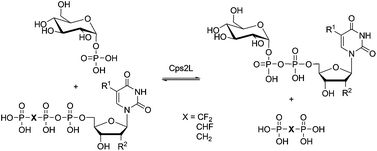The effect of bisphosphonate acidity on the activity of a thymidylyltransferase†
Abstract
Thymidylyltransferases (

* Corresponding authors
a Department of Chemistry, Dalhousie University, 1459 Oxford St., Halifax, Nova Scotia, Canada
b
College of Pharmacy Dalhousie University, 5968 College St., Halifax, Nova Scotia, B3H 3J5 Canada
E-mail:
david.jakeman@dal.ca
Fax: +1 902 494 1396
Tel: +1 902 494 7159
Thymidylyltransferases (

 Please wait while we load your content...
Something went wrong. Try again?
Please wait while we load your content...
Something went wrong. Try again?
S. A. Beaton, P. M. Jiang, J. C. Melong, M. W. Loranger, S. Mohamady, T. I. Veinot and D. L. Jakeman, Org. Biomol. Chem., 2013, 11, 5473 DOI: 10.1039/C3OB41017J
To request permission to reproduce material from this article, please go to the Copyright Clearance Center request page.
If you are an author contributing to an RSC publication, you do not need to request permission provided correct acknowledgement is given.
If you are the author of this article, you do not need to request permission to reproduce figures and diagrams provided correct acknowledgement is given. If you want to reproduce the whole article in a third-party publication (excluding your thesis/dissertation for which permission is not required) please go to the Copyright Clearance Center request page.
Read more about how to correctly acknowledge RSC content.
 Fetching data from CrossRef.
Fetching data from CrossRef.
This may take some time to load.
Loading related content
